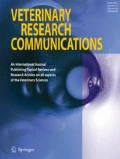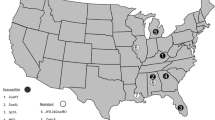Abstract
Doxycycline is an antibiotic that, in addition to the classic antibacterial use, is also prescribed to fight parasitic diseases, like heartworm disease in dogs. Despite the concern that the overuse of this antibiotic may decrease susceptibility of clinically important bacteria, the consequences of the prolonged doxycycline therapy in heartworm-infected dogs have never been studied before. We have analyzed the impact of this therapy on Staphylococcus aureus and Enterococcus antimicrobial resistance. In this study, 17 heartworm-infected dogs (10 that had completed the doxycycline treatment and 7 dogs that had not yet begun) were included. Twenty-four isolates of Staphylococcus aureus were obtained from two locations of each dog. After treatment, 73.3% of isolates were resistant to at least one antibiotic but only 22.2% of isolates before treatment. Most of doxycycline resistant isolates were obtained from dogs that have received treatment. Erythromycin resistance or intermediate susceptibility was detected in 45.6% of isolates, most of them from dogs after treatment. For Enterococci, 48 isolates were obtained from fecal samples (25 before treatment and 23 after treatment). Before treatment, 32% of isolates were resistant at least to one antibiotic while after, this data increase up to 65%. Comparing isolates before and after treatment, a clear increase in resistance to doxycycline (12% against 21.74%) and erythromycin (20% against 39.13%) was observed. Although the present work is a preliminary research, the results encourages the development of further studies to determinate the effect of prolonged doxycycline therapy on antimicrobial resistance.
Similar content being viewed by others
References
Aarestrup FM, Agerso Y, Gerner-Smidt P, Madsen M, Jensen LB (2000) Comparison of antimicrobial resistance phenotypes and resistance genes in Enterococcus fecalis and Enterococcus faecium from humans in the community, broilers and pigs in Denmark. Diagn Microbiol Infect Dis 37:127–137
Abdel-Moein KA, El-Hariri MD, Wasfy MO, Samir A (2017) Occurrence of ampicillin-resistant Enterococcus faecium carrying esp gene in pet animals: an upcoming threat for pet lovers. J Glob Antimicrob Resist 9:115–117
Alonzo F, Torres VJ (2013) A lesson in survival: S. aureus versus the skin. Cell Host Microb 13:3–5. https://doi.org/10.1016/j.chom.2013.01.001
Bean DC, Wigmore SM (2016) Carriage rate and antibiotic susceptibility of coagulase-positive sthaphylococci isolated from healthy dogs in Victoria, Australia. Aus Vet J 94:456–460
Beça N, Bessa LJ, Mendes A, Santos J, Leite-Martins L, AJF M, da Costa PM (2015) Coagulase-positive Staphylococcus: prevalence and antimicrobial resistance. J Am Anim Hosp Assoc 51:365–371
Boost MV, O’Donoghue MM, James A (2008) Prevalence of Staphylococcus aureus carriage among dogs and their owners. Epidemiol Infect 136:953–964
Carretón E, Morchón R, Simón F, Juste MC, González-Miguel J, Montoya-Alonso JA (2014) Evaluation of cardiopulmonary biomarkers during classic adulticide treatment versus the American heartworm society recommended treatment protocol in dogs infected by Dirofilaria immitis. Vet Parasitol 206:55–59
De Francesco EM, Maggiolini M, Tanowitz HB, Sotgia F, Lisanti MP (2017) Targeting hypoxic cancer stem cells (CSCs) with doxycycline: implications for optimizing anti-angiogenic therapy. Oncotarget 8:56126–56142
Diep BA, Gill SR, Chang RF, Phan TH, Chen JH, Davidson MG, Lin F, Lin J, Carleton HA, Mongodin EF, Sensabaugh GF, Perdreau-Remington F (2006) Complete genome sequence of USA300, an epidemic clone of community-acquired meticillin-resistant Staphylococcus aureus. Lancet 367:731–739
Eaton TJ, Gasson MJ (2001) Molecular screening of Enterococcus virulence determinants and potential for genetic exchange between food and medical isolates. Appl Environ Microbiol 67:1628–1635
Ganiere JP, Medaille C, Mangion C (2005) Antimicrobial drug susceptibility of Staphylococcus intermedius clinical isolates from canine pyoderma. J Veterinary Med Ser B 52:25–31
Griffeth GC, Morris DO, Abraham JL, Shofer FS, Rankin SC (2008) Screening for skin carriage of methicillin-resistant coagulase-positive staphylococci and Staphylococcus schleiferi in dogs with healthy and inflamed skin. Vet Dermatol 19:142–149
Iseppi R, Messi P, Anacarso I, Bondi M, Sabia C, Condò C, de Niederhausern S (2015) Antimicrobial resistance and virulence traits in Enterococcus strains isolated from dogs and cats. New Microbiol 38:369–378
Jackson CR, Fedorka-Cray PJ, Davis JA, Barrett JB, Frye JG (2009) Prevalence, species distribution and antimicrobial resistance of enterococci isolates from dogs and cats in the United States. J Appl Microbiol 107:1269–1278
Jayaweera AASJ, Kumbukgolla WW (2017) Antibiotic resistance patterns of methicillin-resistant Staphylococcus aureus (MRSA) isolated from livestock and associated farmers in Anuradhapura, Sri Lanka. Germs 7:132–139
Kataoka Y, Umino Y, Ochi H, Harada K, Sawada T (2014) Antimicrobial susceptibility of enterococcal species isolated from antibiotic-treated dogs and cats. J Vet Med Sci 76:1399–1402
Kern A, Perreten V (2013) Clinical and molecular features of methicillin-resistant, coagulase-negative staphylococci of pets and horses. J Antimicrob Chemother 68:1256–1266. https://doi.org/10.1093/jac/dkt020
Kramer L, Genchi C (2014) Where are we with Wolbachia and doxycycline: an in-depth review of the current state of our knowledge. Vet Parasitol 206:1–4
Kramer L, Grandi G, Leoni M, Passeri B, McCall J, Genchi C, Mortarino M, Bazzocchi C (2008) Wolbachia and its influence on the pathology and immunology of Dirofilaria immitis infection. Vet Parasitol 158:191–195
Kramer L, Grandi G, Passeri B, Gianelli P, Genchi M, Dzimianski MT, Supakorndej P, Mansour AM, Supakorndej N, McCall SD, McCall JW (2011) Evaluation of lung pathology in Dirofilaria immitis-experimentally infected dogs treated with doxycycline or a combination of doxycycline and ivermectin before administration of melarsomine dihydrochloride. Vet Parasitol 176:357–360
McCall JW, Genchi C, Kramer L, Guerrero J, Dzimianski MT, Supakorndej P, Mansour AM, McCall SD, Supakorndej N, Grandi G, Carson B (2008a) Heartworm and Wolbachia: therapeutic implications. Vet Parasitol 158:204–214
McCall JW, Genchi C, Kramer LH, Guerrero J, Venco L (2008b) Heartworm disease in animals and humans. Adv Parasitol 66:193–285
McCall JW, Kramer L, Genchi C, Guerrero J, Dzimianski MT, Mansour A, McCall SD, Carson B (2014) Effects of doxycycline on heartworm embryogenesis, transmission, circulating microfilaria, and adult worms in microfilaremic dogs. Vet Parasitol 206:5–13
McManus BA, Coleman DC, Deasy EC, Brennan GI, O’Connell B, Monecke S, Ehricht R, Leggett B, Leonard N, Shore AC (2015) Comparative genotypes, staphylococcal cassette chromosome mec (SCCmec) genes and antimicrobial resistance amongst Staphylococcus epidermidis and Staphylococcus haemolyticus isolates from infections in humans and companion animals. PLOS ONE. https://doi.org/10.1371/journal.pone.0138079
Mende K, Beckius ML, Zera WC, Yu X, Li P, Tribble DR, Murray CK et al (2016) Lack of doxycycline antimalarial prophylaxis impact on Staphylococcus aureus tetracycline resistance. Diagn Microbiol Infect Dis 86:211–220
Morchón R, Carretón E, González-Miguel J, Mellado-Hernández I (2012) Heartworm disease (Dirofilaria immitis) and their vectors in Europe - new distribution trends. Front Physiol 3:196
Nelson CT, Myrick ES, Nelson TA (2017) Clinical benefits of incorporating doxycycline into a canine heartworm treatment protocol. Parasit Vectors 10:515
Nowakiewicz A, Ziółkowska G, Zięba P, Gnat S, Wojtanowicz-Markiewicz K, Trościańczyk A (2016) Coagulase-positive Staphylococcus isolated from wildlife: identification, molecular characterization and evaluation of resistance profiles with focus on a methicillin-resistant strain. Comp Immunol Microbiol Infect Dis 44:21–28. https://doi.org/10.1016/j.cimid.2015.11.003
Prichula J, Inhoque-Pereira R, Raffo-Wachholz G, Almansa-Cardoso L, Correa-Tolfo NC, Aguiar Santestevan N et al (2016) Resistance to antimicrobial agents among enterococci isolated from fecal samples of wild marine species in the southern coast of Brazil. Mar Pollut Bull 105:51–57
R Core Team (2017) R: A language and environment for statistical computing. R Foundation for Statistical Computing, Vienna, Austria. URL https://www.R-project.org/
Rangel de Freitas AA, Rocha Faria A, De Castro Abreu Pinto T, Carreira Mequior VL, Marchesi Neves D, De Cerqueira da Costa R et al (2018) Distribution of species and antimicrobial resistance among enterococci isolated from the fecal microbiota of captive blue-fronted parrot (Amazona aestiva) in Rio de Janeiro, Brazil. Sci Total Environ 615:1428–1437
Simón F, Siles-Lucas M, Morchón R, González-Miguel J, Mellado I, Carretón E, Montoya-Alonso JA (2012) Human and animal dirofilariasis: the emergence of a zoonotic mosaic. Clin Microbiol Rev 25:507–544
Strommenger B, Kettlitz C, Werner G, Witte W (2003) Multiplex PCR assay for simultaneous detection of nine clinically relevant antibiotic resistance genes in Staphylococcus aureus. J Clin Microbiol 41:4089–4094
Sutcliffe J, Grebe T, Tait-Kamradt A, Wondrack L (1996) Detection of erythromycin-resistant determinants by PCR. Antimicrob Agents Chemother 40:2562–2566
Takadama S, Nakaminami H, Aoki S, Akashi M, Wajima T, Ikeda M, Mochida A, Shimoe F, Kimura K, Matsuzaki Y, Sawamura D, Inaba Y, Oishi T, Nemoto O, Baba N, Noguchi N (2017) Prevalence of skin infections caused by Panton-valentine leukocidin-positive methicillin-resistant Staphylococcus aureus in Japan, particularly in Ishigaki, Okinawa. J Infect Chemother 23:800–803
Tan KR, Magill AJ, Parise ME, Arguin PM (2011) Doxycycline for malaria chemoprophylaxis and treatment. Report from the CDC expert meeting on malaria chemophylaxis. Am J Trop Hyg 84:517–531
Tang X, Wang X, Zhao YY, Curtis JM, Brindley DN (2017) Doxycycline attenuates breast cancer related inflammation by decreasing plasma lysophosphatidate concentrations and inhibiting NF-κB activation. Mol Cancer 16:36. https://doi.org/10.1186/s12943-017-0607-x
Taylor MJ, Hoerauf A (2001) A new approach to the treatment of filariasis. Curr Opin Infect Dis 14:727–731
Taylor MJ, Bandi C, Hoerauf A (2005) Wolbachia bacterial endosymbionts of filarial nematodes. Adv Parasitol 60:245–284
Taylor MJ, Hoerauf A, Bockarie M (2010) Lymphatic filariasis and onchocerciasis. Lancet 376:1175–1185
Vento TJ, Calvano TP, Cole DW, Mende K, Rini EA, Tully CC, Landrum ML, Zera W, Guymon CH, Yu X, Beckius ML, Cheatle KA, Murray CK (2013) Staphylococcus aureus colonization of healthy military service members in the United States and Afghanistan. BMC Infect Dis 13:325
Wipf JRK, Perreten V (2016) Methicillin-resistant Staphylococcus aureus isolated from dogs and cats in Switzerland. Schweiz Arch Tierheilkd 158:443–450. https://doi.org/10.17236/sat00070
Yang C, Wan MT, Lauderdale TL, Yeh KS, Chen C, Hsiao YH, Chou CC (2017) Molecular characteristics of clinical methicillin-resistant Staphylococcus pseudintermedius harboring arginine catabolic mobile element (ACME) from dogs and cats. Vet J 224:46–49
Author information
Authors and Affiliations
Corresponding author
Ethics declarations
Conflicts of interest
The authors declare they have no conflict of interest.
Ethical approval
All applicable international, national, and/or institutional guidelines for the care and use of animals were followed.
Rights and permissions
About this article
Cite this article
Tejedor-Junco, M.T., González-Martín, M., Bermeo-Garrido, E. et al. Doxycycline treatment for Dirofilaria immitis in dogs: impact on Staphylococcus aureus and Enterococcus antimicrobial resistance. Vet Res Commun 42, 227–232 (2018). https://doi.org/10.1007/s11259-018-9727-z
Received:
Accepted:
Published:
Issue Date:
DOI: https://doi.org/10.1007/s11259-018-9727-z




